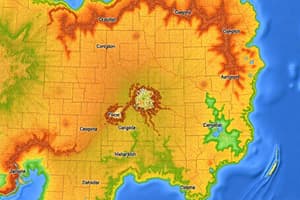Podcast
Questions and Answers
What is the primary purpose of a GIS?
What is the primary purpose of a GIS?
- To provide a platform for social media integration
- To analyze and visualize geospatial data (correct)
- To store and manage large datasets
- To create detailed maps and charts
What are the two types of geospatial data?
What are the two types of geospatial data?
- Line and Surface
- Attribute and Feature
- Point and Polygon
- Vector and Raster (correct)
What is the term for the dimension of the pixel size in a raster data?
What is the term for the dimension of the pixel size in a raster data?
- Scale
- Resolution (correct)
- Accuracy
- Precision
What is a feature in the context of GIS?
What is a feature in the context of GIS?
What is a shapefile?
What is a shapefile?
What is the minimum number of file types required for a shapefile?
What is the minimum number of file types required for a shapefile?
What is the term for the use of symbols to represent the attributes and features of a map layer?
What is the term for the use of symbols to represent the attributes and features of a map layer?
What type of data is referenced to particular positions on the earth's surface?
What type of data is referenced to particular positions on the earth's surface?
What is the purpose of the Calculate Geometry tool?
What is the purpose of the Calculate Geometry tool?
What is the term for 'data about the data' in GIS?
What is the term for 'data about the data' in GIS?
What is the file extension for an ArcGIS Pro project file?
What is the file extension for an ArcGIS Pro project file?
A GIS is used to aid in the handling of non-geospatial data and information.
A GIS is used to aid in the handling of non-geospatial data and information.
A shapefile must have a minimum of four file types: .shp, .shx, .dbf, and .prj.
A shapefile must have a minimum of four file types: .shp, .shx, .dbf, and .prj.
A geodatabase can only store vector data.
A geodatabase can only store vector data.
Vector data is used to represent continuous data such as elevation, soil pH, and other environmental applications.
Vector data is used to represent continuous data such as elevation, soil pH, and other environmental applications.
The Define Projection tool is used to calculate the area of a feature.
The Define Projection tool is used to calculate the area of a feature.
A feature in GIS can have multiple geometry types.
A feature in GIS can have multiple geometry types.
A layer in GIS stores the actual data.
A layer in GIS stores the actual data.
Shapefile is a raster data format.
Shapefile is a raster data format.
A GIS system consists of four parts: People, Data, Hardware, and Software.
A GIS system consists of four parts: People, Data, Hardware, and Software.
A definition query is used to summarize data in a layer.
A definition query is used to summarize data in a layer.
A selected row in an attribute table is highlighted in red.
A selected row in an attribute table is highlighted in red.
Attribute table contains geometric shapes.
Attribute table contains geometric shapes.
Match the following GIS components with their definitions:
Match the following GIS components with their definitions:
Match the following types of geospatial data with their characteristics:
Match the following types of geospatial data with their characteristics:
Match the following vector data terminology with their definitions:
Match the following vector data terminology with their definitions:
Match the following terms related to GIS features with their definitions:
Match the following terms related to GIS features with their definitions:
Match the following GIS terms with their definitions:
Match the following GIS terms with their definitions:
Match the following GIS concepts with their definitions:
Match the following GIS concepts with their definitions:
Match the following GIS terms with their definitions:
Match the following GIS terms with their definitions:
Match the following ArcGIS Pro components with their descriptions:
Match the following ArcGIS Pro components with their descriptions:
Match the following GIS tools with their functions:
Match the following GIS tools with their functions:
Match the following GIS concepts with their characteristics:
Match the following GIS concepts with their characteristics:
Match the following GIS selection indicators with their descriptions:
Match the following GIS selection indicators with their descriptions:
Match the following GIS file types with their descriptions:
Match the following GIS file types with their descriptions:
Flashcards are hidden until you start studying




